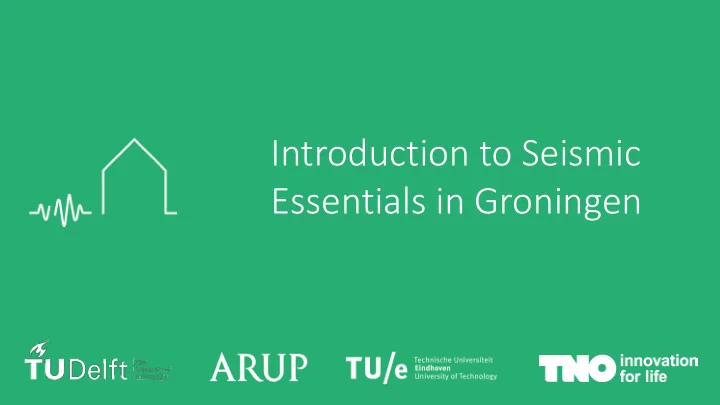

Introduction to Seismic Essentials in Groningen
Lateral Load Resisting 5.3 System Design – Part 2 By Prof Joop Paul MSc PhD – TU Delft / Arup
Seismic Design Principles 1. Use ductile materials 2. Connect all the building elements 3. Minimize mass and mass/strength ratio 4. Minimize eccentricities and plan irregularities 5. Minimize discontinuities and vertical irregularities 6. Ensure energy absorption by designing for ductile failure mechanisms 7. Design multiple lateral load paths
Use ductile materials Brittle materials Ductile materials Member size bigger smaller Failure mode sudden not sudden Energy absorption limited significant Example masonry steel
Connecting all building elements Friction connections Positive connections Design connections member connection Sliding off possible No separation possible Connection is stronger • • • than incoming members
Minimize mass and optimize vertical mass distribution water storage separation walls roofs facade floors storage
Minimize mass Optimize strength/mass ratio Strength/mass ratio Steel Timber Concrete Masonry
Minimize eccentricities Centre of mass
Minimize eccentricities Centre of resistance
Minimize eccentricities Torsional shaking shaking in x-direction shaking in y-direction y y CoR CoR e y x x CoM CoM F x F y e x Torsional moment =
Minimize eccentricities Designing for torsion not good ok better
Minimize plan irregularities CoM CoR
Minimize discontinuities Discontinuity in stiffness h h h h h h not good ok
Minimize discontinuities Discontinuity in mass and stiffness h h h h h h 1,5h h h not good not good ok
Minimize discontinuities Discontinuity in mass and stiffness not good not good ok
Minimize discontinuities Podium buildings pinned on separation of tower flexible tower and columns podium podium not good ok ok
Ensure energy absorption Predictable ductile failure mechanisms mechanism 1 mechanism 2 mechanism 3 weak beam strong column affected = affected = not affected = not good not good good
Ensure energy absorption Design of “plastic” fuses excentric portal braced frame braced frame F F local bending local axial local bending + deformation deformation shear deformation
Ensure energy absorption Design of “plastic” fuses excentric portal braced frame braced frame detail detail detail F F moment capacity axial capacity shear capacity
Design multiple lateral load paths not redundant redundant more redundant = not good = good = better
Design multiple lateral load paths not redundant redundant more redundant = not good = good = better
Seismic Design Principles 1. Use ductile materials 2. Connect all the building elements 3. Minimize mass and mass/strength ratio 4. Minimize eccentricities and plan irregularities 5. Minimize discontinuities and vertical irregularities 6. Ensure energy absorption by designing for ductile failure mechanisms 7. Design multiple lateral load paths
Thank you for your attention!
References and further reading 5.3 Charleson, A. (2008). Seismic Design for Architects - outwitting the quake. Published by Routledge – Architectural Press.
Recommend
More recommend